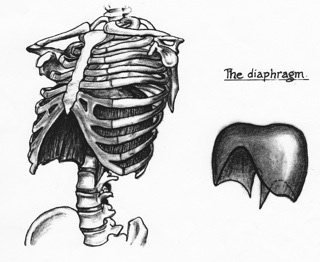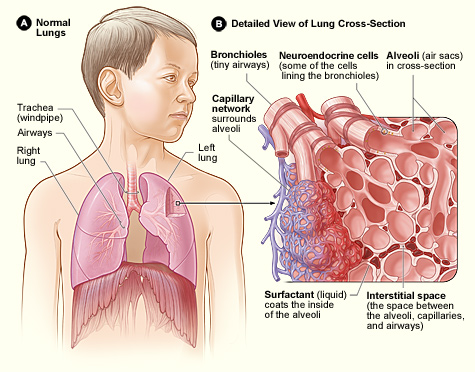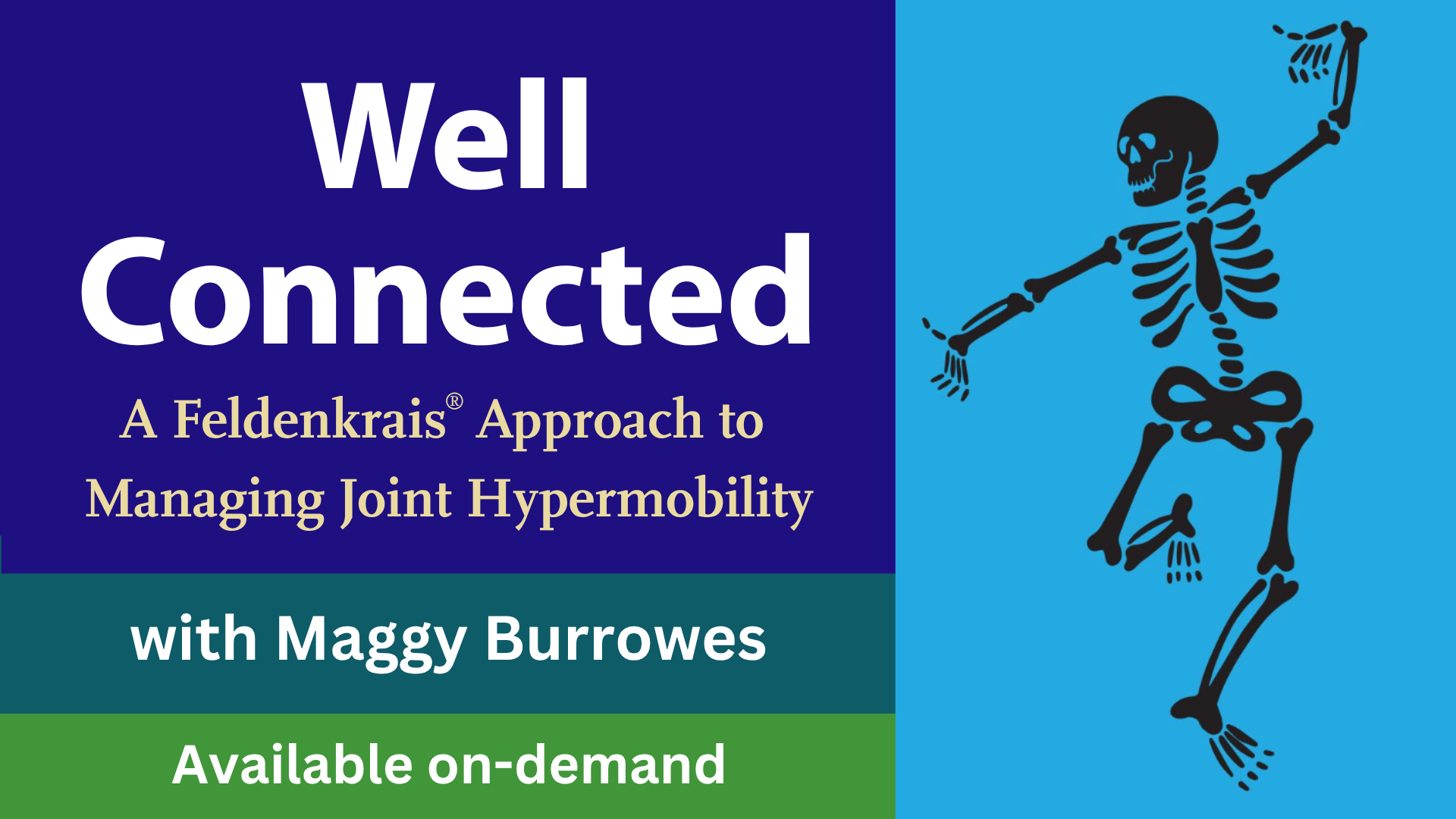The Lungs
The lungs, our primary organs of respiration, are contained within the chest cavity. Shaped rather like an orange segment divided in two, they are spongy, balloon-like organs made up of millions of tiny air sacs, giving them a massive estimated internal surface area between 50 and 75 square metres. All the organs are vulnerable, but the lungs are particularly so, and thus these delicate structures are encased in a ‘cage’ of strong-yet-flexible rib bones. The right lung has three lobes and is slightly larger than the left which has only two. Our heart is situated on the left side of the chest, and is securely encased by our lungs inside our rib cage.

Ribs, Diaphragm and Psoas © Carla Drayton
Breathing as an Automatic Process*
As a general rule we do not tend to notice our breathing unless something has influenced it in some way, and even when we experience a change in circumstances that necessitates a spontaneous shift, then the change in our breathing may not be the first thing we notice. This is not surprising, unconscious breathing is a “vegetative” process, under the control of the Autonomic Nervous System, and were it to demand too much regular attention it would interfere with our daily life in a most inefficient way. Healthy natural breathing makes automatic adjustments to sudden changes of pace, and the fitter we are–i.e. the more efficiently our lungs process oxygen–the more easily we adjust to a sprint for the bus, or tackle a long flight of stairs. There is even evidence that aerobic fitness can support us in the event of a sudden emotional shock…
Breathing and Our Emotions
Shifting emotions also trigger distinctive adjustments to our breathing and for many of us this can lead to not allowing our breathing to be as free and full as it could be. The sudden, dramatic and uncensored changes of emotion seen in young children are not acceptable in adult society, and the process of masking our emotions from those around us begins early. Some are so successful at it they manage to conceal their feelings from themselves as well as others. What better way to mask feelings of, say, anger, than to be unaware of having those feelings yourself? Emotions are complex, and difficult to manage, but their physical manifestations are less so. Stop and think about how it feels to cry, and notice the feelings generated in your chest, throat and solar plexus. How would you disguise the impulse to cry? Probably you can sense that you would hold one or more of these areas rigid. This voluntary donning of a muscular corset can become habitual and chronic if repeated often enough, at which point it is much harder to reverse–and is a common cause of the sort of chronically high muscular tonus that can lead to posture problems, even in young children. As adults we may start to recognise these emotional limitations and yearn to be more spontaneous and expressive. Many people discover the Feldenkrais Method as part of the process of unravelling the habitual tensions they have been using to maintain their emotional constraints.
The Diaphragm
The diaphragm is a large, domed sheet of muscle dividing the torso in two, above which the lungs sit. It is attached to the lowest parts of the ribcage, including the floating ribs, and anchored to the lumbar spine by a strong central tendon that branches left and right. The heart nestles between the lungs, taking up more space on the left, hence the smaller two-lobed structure of the left lung compared to three lobes on the right.
Inhalation is initiated by the lowering and flattening of the diaphragm as it contracts, triggered by the action of this central tendon. The widening of the diaphragm that this contraction produces causes the rib cage to expand outwards and upwards to a variable degree, and, if necessary, each breath can also be topped up by raising the clavicles.
The filling of the lungs with air is a passive response to the increased space inside the chest cavity; the lungs expand exactly as a sponge would if you had first compressed it between your hands, and then released it again.
On exhaling the diaphragm relaxes upwards and the ribs relax downwards, contracting the chest cavity and thus expelling the processed air. The lungs are structured to retain a percentage of air in order not to collapse, nevertheless it is rare that we expel the exhausted air as completely as we are able to. Learning to exhale fully is a positive step back towards the well-coordinated breathing that came naturally when we were infants, whether we were laughing with delight or crying with frustration. Extending your exhalation, combined with learning to inhale through the nose rather than the mouth, can make a considerable difference to the health of asthmatics, and anyone who suffers from sleep apnoea, snoring, or hyperventilation.
Breathing Coordination Training Website
This website is designed solely for the purpose of sharing a process elegantly designed to re-establish natural breathing coordination, via extending the out-breath and utilising the vocal apparatus for that purpose. It is an easy process to follow and I recommend this website to anyone with breathing issues of any sort.
Functional Breathing
When the diaphragm lowers, the contents of the abdomen are pushed downwards and forwards causing the belly to round, and this regular massaging of the organs by the upward and downward movements of the diaphragm, both above and below, is another benefit of natural breathing. Unfortunately, when the belly is hard and tight, whether for aesthetic or psychological reasons, the diaphragm cannot work as it is designed to, and instead the ribs are forced upwards into an excessively raised position. The downward movement of the diaphragm creates about 60% of the lung’s capacity; the expansion of the ribs another 30%; and the lifting of the clavicles–which often prompts the lifting of the shoulders as well–the final 10%. Thus a tight belly can severely limit your air supply. To make matters worse, this clavicle-lifting action both mimics an excited, anxious or distressed emotional state and requires more energy than natural breathing as our muscles are having to work harder against gravity. Another factor is that this clavicular action can triggers an immediate impulse to exhale and if this is not resisted, this accelerated breathing cycle can lead to chronic and/or habitual hyperventilation. Learning to exhale fully is thus a powerful calming tool, as well as being vital for long-term health.
Charisma
All truly expressive singers and actors have a free and flexible chest to go with their soft, responsive belly, as mobility in both these areas is a major factor in the kind of physical and emotional self-awareness that is the essence of a truly charismatic performer.
*Breathing as a Conscious Process
This is a much bigger subject, so just to say that the vast majority of creatures breath unconsciously, underwater mammals can only breath consciously as they have to rise to the surface to do so, and humans are somewhat unusual as we do both as a matter of course! I have covered this more fully in the blog that precedes this one.
The Embodied Voice course combines Feldenkrais Awareness Through Movement® with state-of-the-art information on the structure and function of our vocal equipment, now available thanks to the developments of modern science. It is aimed at anyone who wishes to develop a conscious, flexible, strong, healthy voice–whether their interest is singing, speaking well as an actor, or freeing their natural voice as a healing and/or spiritual process–and of course any combination of these goals. The idea is to understand how your voice works and develop your vocal confidence and awareness so that with practice your voice can become fully integrated both physically and emotionally, in other words an effortlessly embodied voice.
Originally posted on 20.7.15





One thought on “Breathing–Anatomy & Function”